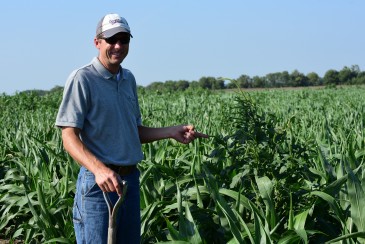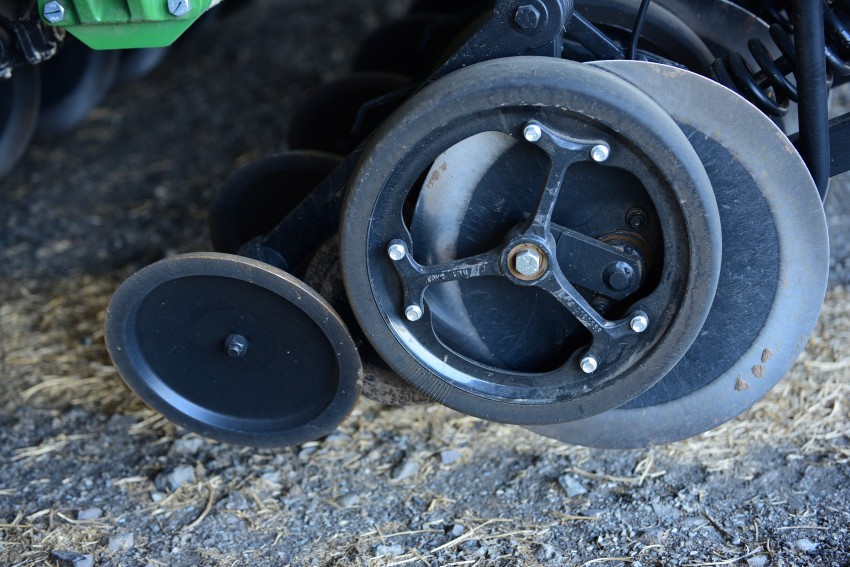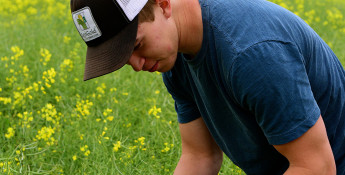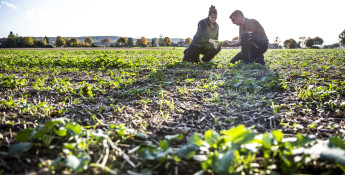By Rick McNary on September 14, 2018
Soil Health and Our Food

Are you curious about where your food comes from? Do you enjoy learning about the origins of what you eat and feed your family? If so, then a good place to start is at the base: soil. Justin Knopf, a farmer who lives near Gypsum tells us how important soil is to the food we all eat.
“It all starts with the soil,” Knopf says as he picks up a handful. “Most farmers care deeply about the soil. For us, it’s not only stewardship of our land, but also stewardship of our lifestyle.”
Asking a farmer about soil is like asking a newlywed about their honeymoon. Their eyes light up. Farmers become animated explaining the fascinating world that lives below our feet. While you and I might see soil, they see a living, breathing community of organisms from which they draw their life and livelihood.
Knopf, a fifth-generation farmer, carries on the family tradition of utilizing the latest scientific and technological advances to understand the ecological system of their farms.
“Soil is alive,” says Knopf, who graduated with a degree in agronomy from Kansas State University. “We are unable to identify more than 90 percent of the organisms in the soil because we have no genetic code for them. This underground system is incredibly complex.”
Learning from the Past
During the 1920s, a national focus supported by land speculators, government agencies and financial institutions encouraged farmers in Kansas, Oklahoma and Texas to turn hundreds of thousands of acres of prairie into farmland. The soil was turned over with deep, moldboard plows, then worked and reworked to provide a tilled surface suitable for planting wheat. Each implement that touched it created a finer, looser soil.
This method exposed the soil to vulnerabilities such as water and soil running off during torrential rains or massive dust storms that carried topsoil as far away as Washington, D.C.
“My grandma lived during the Dust Bowl,” Knopf says. “She told stories of how they soaked sheets in water, then hung them over the doors and windows to keep the soil out. Farmers during that time didn’t have the sophisticated science and technology we have; they did the best they could with what they knew.”
Farmers like Knopf now focus their farming practices on regenerative agriculture - the concept of using techniques such as no-till farming (not tilling up the soil) and cover crops (keep on reading to learn more) to regenerate the soil and prevent erosion. Rich, fertile soil provides increased yields as well as long-term sustainability. However, the same fertile soil is also ideal for growing the farmer’s biggest enemy: weeds.
Pigweed: The Farmer’s Nemesis
“Weeds are my nemesis and they are worse this year than any year in my past,” Knopf says. “Pigweed, also known as Palmer amaranth, is the most difficult to control. Biology will always adapt to our practices, and pigweed is becoming resistant to herbicides. One pigweed can produce 500,000 to 700,000 seeds. Left unchecked, they will take over a field and choke out my crops.”
One way to control the weeds is through the application of herbicide or tilling the ground. Another way is by preventing the weed’s growth by growing a canopy of other plants called cover crops.
Cover Crops
Knopf is a part of Grounded Growth, a group that connects farmers and businesses to focus on regenerative agriculture, of which cover crops play a significant role.
“Companies are listening to farmers and consumers about how food is grown and are interested in regenerative agriculture,” Knopf says. “I received a grant from them to experiment in one field with a smorgasbord of millet, turnips, flax, sunflower and radishes that will choke out the pigweed.
“Basically, by growing cover crops we are creating a biological competition against the weeds.”
In addition to the biological competition created by the cover crops, they return carbon to the soil and other organic benefits. Radishes, for example, expand underground and create tunnels for rainwater to soak in deeper.
No-Till Farming
After a crop is harvested, a farmer has to decide what to do with the remaining plant matter they call residue. Some choose to burn the residue off or till it back into the soil with an implement such as a moldboard plow. Others, like Knopf, choose a no-till method and leave the residue as it is. Farmers go over the residue with an implement using thin discs that slice through the residue and soil then drops a seed in and covers it up. The residue forms a mulch-like environment.
“If we leave the residue, it becomes a stable habitat for a variety of biological organisms that are good for the soil,” Knopf says.
The Knopf farm recently drew the attention of Miriam Horn of the Environmental Defense Fund in New York City. She wanted to write a book about the farming and ranching practices intended to help the environment.
“I told her no several times because I’ve sadly seen examples of the media falsely portraying farmers as people destroying the environment to maximize profits with no regard to the future,” Knopf says. “But I finally realized if she was going to be sincere, then shame on me for not taking the opportunity to tell our story. I’m so glad I chose to participate. Miriam is an incredibly gifted writer and I am very pleased how the project turned out.”
Initially intended to just be a book, Rancher, Farmer, Fisherman – Conservation Heroes of the American Heartland, was turned it into a documentary by the Discovery Channel.
Farmers like Justin Knopf are the norm rather than the exception. There is no group that cares about sustainability more than the American farmer. Many are like Knopf –those in a long line of generational farming who feel it’s their responsibility to ensure that the 10th and 20th generations of their family farm find it in better condition than generations before them left it.
The next time you walk through your grocery store trying to sort out the confusing messages about where your food comes from, consider learning about the place where your food takes root – the soil. And there is no better way to learn it than from a farmer. Find one and ask them to tell you about soil.
Don’t be surprised when their eyes light up and they grow more animated; they have a way of making you as fascinated by soil as they are.







